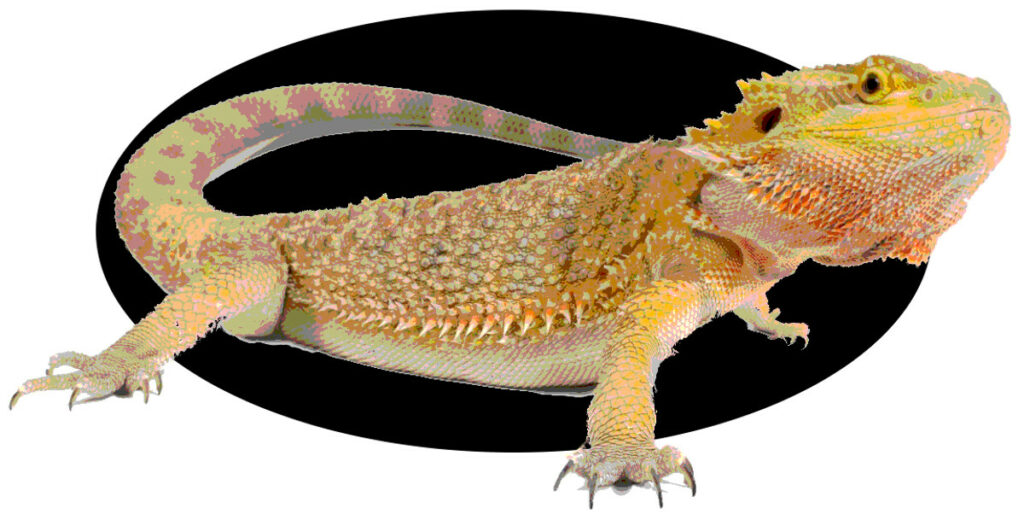Брадатите дракони са всеядни, което означава, че имат разнообразна диета, състояща се както от животински протеини (предимно насекоми) и растителна материя. Балансираната диета е от съществено значение за тяхното здраве.
В дивата природа, bearded dragons have a varied diet that typically includes a combination of insects, small invertebrates, и растителна материя.
Their natural diet may consist of insects like crickets, скакалци, ants, бръмбари, and termites.
They also feed on vegetation such as leaves, цветя, плодове, and even the occasional small vertebrate or rodent.
Wild bearded dragons are opportunistic feeders, meaning they eat what is available to them based on their location and seasonal changes in food availability.
Тази страница съдържа партньорски връзки. Като сътрудници на Amazon може да печелим комисионна за покупки на отговарящи на условията продукти. Това е без допълнителни разходи за вас.
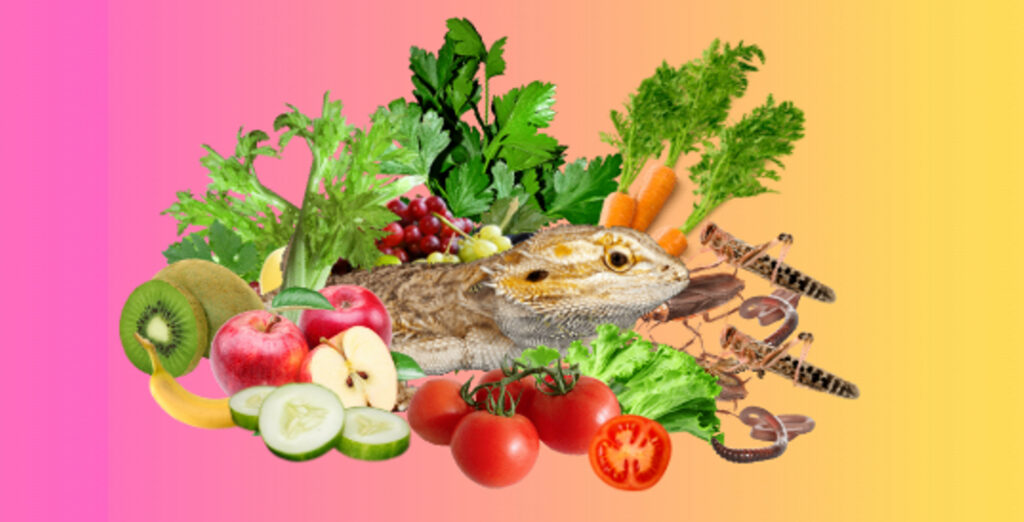
Като домашни любимци, bearded dragons should be fed a diet that is as close to their natural diet as possible.
This means feeding them a variety of insects, small invertebrates, и растителна материя.
Some good options for insects include crickets, брашнени червеи, dubia хлебарки, и копринени буби.
Some good options for plant matter include collard greens, зеле, моркови, and sweet potatoes.
It is also important to dust the insects you feed your bearded dragon with calcium powder to help ensure they are getting enough calcium.
Recommended Diet and Feeding
Процентът на насекоми и зеленчуци в диетата на брадат дракон трябва да варира в зависимост от възрастта им.
Възрастни
Възрастните трябва да се хранят с диета, която е 15% насекоми и 85% зеленина. Това е така, защото те не се нуждаят от толкова протеини, колкото новоизлюпените и младите, и те могат да получат необходимия калций от зеленчуците си.
Тъмните листни зеленчуци с високо съдържание на n3 мастни киселини са особено важни за възрастните, тъй като те могат да помогнат за намаляване на възпалението и подобряване на цялостното здраве.
Непълнолетни
Младите трябва да се хранят с диета, която е 15-30% зелени и 70-85% насекоми. Това е така, защото те все още растат и се развиват, и те се нуждаят от протеина и калция, които насекомите осигуряват.
Важно е да се предлагат различни насекоми на младите, включително щурци, брашнени червеи, и dubia хлебарки.
| Възраст | Насекоми | Зеленчуци | График на хранене |
|---|---|---|---|
| люпила (0-3 месеца) | 85% | 15% | 4-5 пъти на ден |
| Непълнолетни (4-12 месеца) | 70-80% | 20-30% | 2-3 пъти на ден |
| Възрастни (1-7 години) | 15-30% | 70-85% | 1-2 пъти на ден |
| Възрастни хора (> 7 години) | 15% | 85% | 1-2 пъти на ден |
Излюпените и младите брадати дракони се нуждаят от много хранителни насекоми, за да им помогнат да растат и да се развиват.
Трябва да им се предлага толкова, колкото ще изядат, 4-5 пъти на ден. Докато растат, те ще започнат да разчитат по-малко на насекоми и повече на зеленчуци и зеленчуци.
Възрастните брадати дракони се нуждаят само от малко 15% насекоми в диетата си, и ще ядат по-рядко с възрастта.
Добра идея е да натоварвате насекомите с червата (хранете ги с питателна храна) и ги поръсете с добавки с калций и мултивитамини, за да сте сигурни, че вашият дракон получава основни хранителни вещества.
Feeder Insects
Here are some of the best feeder insects for bearded dragons:
| Insect | Протеин (%) | Fat (%) | калций (mg/kg) | Phosphorus (mg/kg) |
|---|---|---|---|---|
| Хлебарки Dubia | 21.4 | 3.1 | 700 | 2600 |
| Goliath Worms | 9 | 3.07 | 464 | 1394 |
| Восъчни червеи | 14.1 | 24.9 | 243 | 1650 |
| Суперчервеи | 19.7 | 17.7 | 177 | 2370 |
| Брашнени червеи | 18.7 | 13.4 | 169 | 2950 |
| Щурци | 15.4 | 3.3 | 275 | 2520 |
| Black Soldier Fly Larvae | 17.5 | 14 | 9340 | 3560 |
| Butterworms | 15.5 | 29.4 | 125 | 2250 |
| Копринени буби | 9.3 | 1.1 | 177 | 2370 |
Хлебарки Dubia
Dubia roaches are a popular choice for bearded dragon owners because they are high in protein and calcium, low in fat, и лесен за грижа.
They can be purchased online or at most pet stores.

Hornwarms / Goliath Worms
Hornwarms aka Goliath worms are another good option for bearded dragons.
They are high in moisture and nutrients, and they are also a good source of beta-carotene, which can help to improve the color of your dragon’s beard.

Восъчни червеи
Waxworms are a high-fat insect, so they should only be fed as a treat.
въпреки това, they are a good source of energy and can be helpful for dragons that are recovering from illness or surgery.

Суперчервеи
Superworms are similar to mealworms, but they are larger and have a softer exoskeleton.
This makes them easier for bearded dragons to digest.

Брашнени червеи
Mealworms are a good source of protein and calcium, but they can be hard for young bearded dragons to digest.
They should only be fed as part of a varied diet.

Щурци
Crickets are a common feeder insect, and they are a nutritious choice for bearded dragons which is very low in fat.
They are however not the easiest to keep, as and they can be noisy and messy.

Black Soldier Fly Larvae
Black soldier fly larvae are an excellent feeder insect for bearded dragons.
They have a high calcium content and are easy to gut-load.
They can be a bit more expensive than other feeder insects, but they are worth the investment.

Butterworms
Butterworms are another good option for bearded dragons.
They are high in protein and calcium, and they are also a good source of fat.
They can be a bit messy, but they are a popular choice for dragons.

Копринени буби
Silkworms are not as common as other feeder insects, but they can be a good option for bearded dragons.
They are high in protein and calcium, and they are also a good source of fiber.
въпреки това, they can be difficult to find and can be expensive.

Vegetables and fruit
The diet of an adult bearded dragon should consist of approximately 85% greens and vegetables. Vegetables are an important source of vitamins, minerals, and fiber for bearded dragons. Dark leafy greens rich in n3 fatty acids should be the primary focus.
Here is a breakdown of the different types of vegetables that bearded dragons can eat:
Primary non-goitrogenic greens
These greens are low in oxalates and can be fed to your dragon every day. They are a good source of vitamins, minerals, and fiber.
Try to provide at least two different types of these greens and rotate them often.
- Зелените глухарчета: Dandelion greens are a good source of vitamins A, ° С, and K, as well as calcium and fiber. They are also a good source of antioxidants.
- Endive/escarole: Endive and escarole are similar greens that are also low in oxalates. They are a good source of vitamins A, ° С, and K, as well as calcium and fiber.
- Alfalfa: Alfalfa sprouts are a good source of vitamins A, ° С, and K, as well as calcium and fiber. въпреки това, alfalfa sprouts can be high in phosphorus, so it is important to limit the amount that you feed your dragon.
- Arugula: Arugula is a good source of vitamins A, ° С, and K, as well as calcium and fiber. Освен това е добър източник на антиоксиданти.
- Carrot tops: Carrot tops are a good source of vitamins A, ° С, and K, as well as calcium and fiber. They are also a good source of antioxidants.
Primary goitrogenic greens
These greens are higher in oxalates, but they are still healthy for bearded dragons. You can feed them often as long as you rotate between these and non-goitrogenic greens.
- Зеленчуци: Collard greens are a good source of vitamins A, ° С, and K, as well as calcium and fiber. They are also a good source of antioxidants.
- Горчица: Mustard greens are a good source of vitamins A, ° С, and K, as well as calcium and fiber. They are also a good source of antioxidants.
- Бок чой: Bok choy is a good source of vitamins A, ° С, and K, as well as calcium and fiber. They are also a good source of antioxidants.
- Зелените ряпа: Turnip greens are a good source of vitamins A, ° С, and K, as well as calcium and fiber. They are also a good source of antioxidants.
- кресон: Watercress is a good source of vitamins A, ° С, and K, as well as calcium and fiber. They are also a good source of antioxidants.
Secondary greens
These greens are safe to feed your dragon, but they are not as nutritious as the primary greens. You may feed these every other day, rotating between them.
- Колраби: Kohlrabi is a good source of vitamins C and K, as well as fiber.
- Beet greens: Beet greens are a good source of vitamins A, ° С, and K, as well as fiber.
- Parsley: Parsley is a good source of vitamins A, ° С, and K, as well as iron and folate.
- Кориандър: Cilantro is a good source of vitamins A, ° С, and K, as well as iron and folate.
- Розмарин: Rosemary is a good source of vitamins A and C, as well as antioxidants.
- босилек: Basil is a good source of vitamins A and C, as well as antioxidants.
Tertiary greens
These greens can be fed to your dragon, but they should be limited to once or twice a week, rotating often.
- зеле: Cabbage is a good source of vitamins C and K, as well as fiber.
- Аспержи: Asparagus is a good source of vitamins A, ° С, and K, as well as fiber.
- листа от целина: Celery leaves are a good source of vitamins A and C, as well as fiber.
Occasional greens (use infrequently)
These greens, due to their high oxalate content, are best fed sparingly.
- Swiss chard: This leafy green is a source of vitamins A, ° С, К, калций, and fiber. въпреки това, due to elevated oxalates, it’s recommended to include it in your dragon’s diet once or twice a week.
- Кейл: Another leafy green rich in vitamins A, ° С, К, калций, and fiber. Nevertheless, it has higher oxalate levels, so it’s advisable to limit it to once or twice a week in your dragon’s diet.
- спанак: Among leafy greens, spinach is known for its abundant vitamins A, ° С, К, калций, and fiber. въпреки това, it contains very high oxalate levels, so use it sparingly.
- Strawberry tops: These are the leaves from strawberry plants, offering vitamins A and C, along with fiber. въпреки това, they also contain some oxalates. It’s recommended to offer them to your dragon once or twice a week.
- Wheatgrass: This young grass is a good source of vitamins A, ° С, and K, калций, and fiber. Nevertheless, it contains some oxalates. Следователно, it’s best to feed it to your dragon once or twice a week.
- Borage greens: Borage greens are leafy vegetables rich in vitamins A and C and packed with antioxidants. въпреки това, they do contain some oxalates. Като резултат, it’s suggested to incorporate them into your dragon’s diet once or twice a week.
- Mulberry leaves: These leaves from mulberry trees offer vitamins A and C and provide antioxidants. They also contain some oxalates. For this reason, it’s advisable to include them in your dragon’s diet once or twice a week.
Frequent vegetables
These vegetables, with their lower oxalate content, can be included more regularly in your dragon’s diet.
- Yellow/summer squash: This variety of squash is abundant in vitamins A and C, калий, and fiber. It’s also a rich source of beta-carotene, an important antioxidant for eye health.
- Green squash/zucchini: This type of squash is rich in vitamins A and C, калий, and fiber. It’s also a great source of beta-carotene, a vital antioxidant for eye health.
- Sweet potato: As a root vegetable, sweet potato offers vitamins A and C, калий, and fiber. It’s also packed with beta-carotene, a crucial antioxidant for maintaining eye health.
- Yam: Another root vegetable, yam provides vitamins A and C, калий, and fiber. It’s also abundant in beta-carotene, an antioxidant that supports eye health.
- Prickly pear pads: These pads from prickly pear cacti supply vitamins A and C, калций, and fiber. They also boast antioxidants.
- Тиква от жълъди: This type of squash is rich in vitamins A and C, калий, and fiber. It’s also packed with beta-carotene, an essential antioxidant for eye health.
- Butternut скуош: Butternut squash provides vitamins A and C, калий, and fiber. It’s also a significant source of beta-carotene, an antioxidant important for eye health.
- Hubbard squash: Hubbard squash is abundant in vitamins A and C, калий, and fiber. It’s also a great source of beta-carotene, a crucial antioxidant for eye health.
- Спагети скуош: This variety of squash offers vitamins A and C, калий, and fiber. It’s also packed with beta-carotene, an antioxidant that supports eye health.
- Chayote squash: This type of squash provides vitamins A and C, калий, and fiber. It’s also a source of antioxidants.
- камби: Bell peppers are a good source of vitamins A and C, калий, and fiber. They are also rich in antioxidants.
- Зелен боб: These beans are a good source of vitamins A and C, калий, фибри, и антиоксиданти.
Less frequent vegetables
These vegetables are safe for your dragon but should be fed less often than the frequent vegetables.
- моркови: This root vegetable is a good source of vitamins A and C, as well as potassium and fiber. It’s also rich in beta-carotene, an antioxidant important for eye health.
- Parsnips: Another root vegetable, parsnips provide vitamins A and C, as well as potassium and fiber.
- Okra: This vegetable is a good source of vitamins C and K, as well as fiber.
- Cucumbers: A vegetable with vitamins C and K and notable for its high water content.
- Peas: These legumes offer vitamins A and C, along with protein and fiber.
- Corn: A grain rich in vitamins A and C, as well as fiber.
- Beets: This root vegetable provides vitamins A and C, калий, and fiber.
- Turnips: Another root vegetable, turnips are rich in vitamins A and C, калий, and fiber.
- тиква: A winter squash offering vitamins A and C, калий, and fiber.
- Radishes: These root vegetables are a good source of vitamins C and K, along with fiber.
- Daikon radishes: Providing vitamins C and K, as well as fiber.
- Artichoke hearts: These are a source of vitamins C and K, фибри, и антиоксиданти.
- Kidney beans: Legumes that offer protein, фибри, and vitamins A and C.
- Lima beans: Providing protein, фибри, and vitamins A and C.
- Pinto beans: These legumes offer protein, фибри, and vitamins A and C.
- Garbanzo beans: Legumes that provide protein, фибри, and vitamins A and C.
- Корен от юка: This root vegetable is a good source of vitamins C and K, as well as fiber.
- Rutabaga: Another root vegetable, rutabaga is rich in vitamins C and K, along with fiber.
Плодове
Fruits can be fed to your dragon as an occasional treat. Most fruits have moderate to high levels of sugar and overfeeding can cause to obesity and other health issues, so moderation is key.
- ягоди: These berries are rich in vitamins C and K and provide fiber. They are relatively low in sugar, making them a suitable choice for regular, but not excessive, consumption.
- Боровинки: Blueberries are packed with vitamins C and K and antioxidants. They have moderate sugar levels, така че трябва да се хранят умерено.
- малини: These fruits provide vitamins C and K and are a good source of fiber. They are relatively low in sugar, making them suitable for occasional consumption.
- пъпеш: This melon offers vitamins A and C, as well as potassium. It contains moderate sugar levels, so it should be fed sparingly.
- Праскови: Peaches are rich in vitamins A and C and provide potassium. They have moderate sugar levels and should be given sparingly.
- Круши: Pears are a source of vitamins A and C, along with fiber. They are relatively low in sugar and can be included in your dragon’s diet occasionally.
- Къпини: These berries are rich in vitamins C and K and fiber. They are relatively low in sugar, making them a suitable choice for regular, but not excessive, consumption.
- Банани: While they provide potassium and vitamin C, bananas have higher sugar levels compared to some other fruits. Offer them sporadically and in smaller quantities.
- Pomegranate: This fruit is known for its antioxidants. It has moderate sugar levels, so it should be fed in moderation.
- папая: Providing vitamins C and A, as well as potassium, papayas contain moderate sugar levels. They should be given sparingly.
- Медена роса: This melon offers vitamins A and C, as well as potassium. It contains moderate sugar levels, so it should be fed sparingly.
- Apple: Apples provide vitamins A and C, along with fiber. They have moderate sugar levels, so they can be included in your dragon’s diet occasionally.
- Apricot: These fruits offer vitamins A and C, as well as potassium. They have moderate sugar levels, making them suitable for occasional consumption.
Foods to Avoid
- Citrus Fruits: Citrus fruits like oranges, lemons, and grapefruits are too acidic for bearded dragons and can upset their digestive system.
- авокадо: Avocado contains substances that are toxic to many animals, including bearded dragons. Avoid feeding any part of the avocado.
- Rhubarb: Rhubarb leaves and stems contain oxalates and other compounds that are toxic to bearded dragons. Do not include rhubarb in their diet.
Опции на Reptilink за брадати дракони
Влечугите са вид диета за цяла плячка за влечуги, които идват под формата на предварително опаковани, замразени връзки „наденица“..
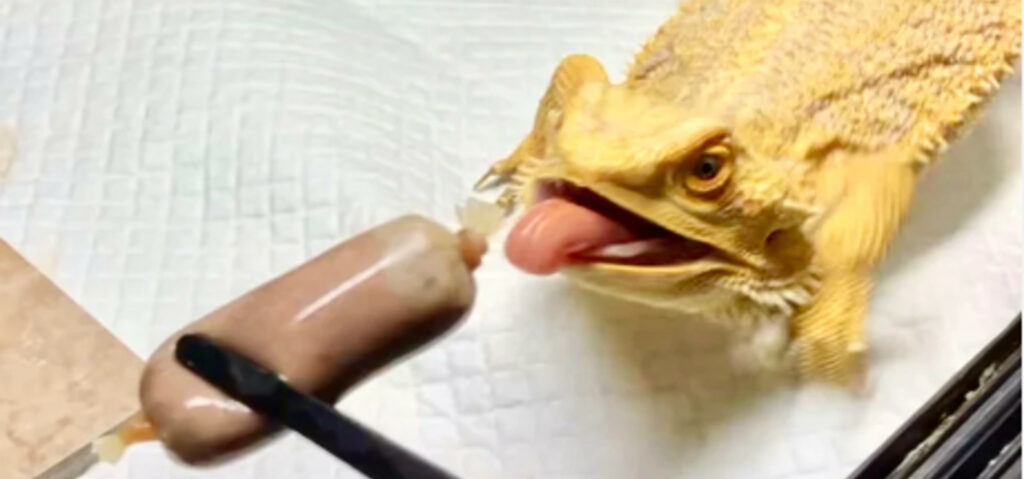
Има две основни смеси от reptilinks, които са специално формулирани за възрастни и млади брадати дракони:
- 50/50 Всеядна смес: Заек (Охайо отгледа новозеландска бяла или калифорнийска бяла порода, включва цял труп), органичен зелен фасул, зеле, зеленина от глухарче, ендивия, 100% обвивка от естествен колаген.
- 25/25/50 Всеядна смес + Насекоми: Насекоми (съскащи хлебарки, щурци, суперчервеи), заек (Охайо отгледа новозеландска бяла или калифорнийска бяла порода, включва цял труп), органичен зелен фасул, зеле, зеленина от глухарче, ендивия, 100% обвивка от естествен колаген.
Можеш получавам $5 отстъпете от следващата си поръчка на Reptilinks, като използвате кода „petswithscales“ при плащане или като поръчате чрез нашата промоционална връзка.

Неща, които трябва да имате предвид
To ensure a healthy diet for your bearded dragon, keep the following considerations in mind:
- Moderation and Rotation: Moderation is crucial to maintain a balanced diet. Rotate the greens and vegetables to prevent overconsumption of specific compounds and ensure a varied nutrient intake.
- Goitrogenic and Oxalate Content: Be cautious with goitrogenic vegetables like kale, broccoli, and cauliflower, as well as high-oxalate foods like spinach and carrots. These should not be staple foods and should be fed in moderation or avoided altogether.
- Avoid Store-Bought Pelleted Food: Store-bought pelleted food is highly processed and lacks the necessary nutritional value and may contain “filler” foods like rice, soy or grains which are not ideal for bearded dragons. If you are looking for alternatives to feeding insects, reptilinks is your best choice.
- Phosphorus Consideration: Excessive phosphorus can hinder calcium absorption. Opt for foods low in phosphorus to ensure proper nutrient balance.
- Добавки. Bearded dragons need lots of calcium and their food should be dusted with calcium supplements and reptile multivitamins to ensure they get all the nutrition they need.
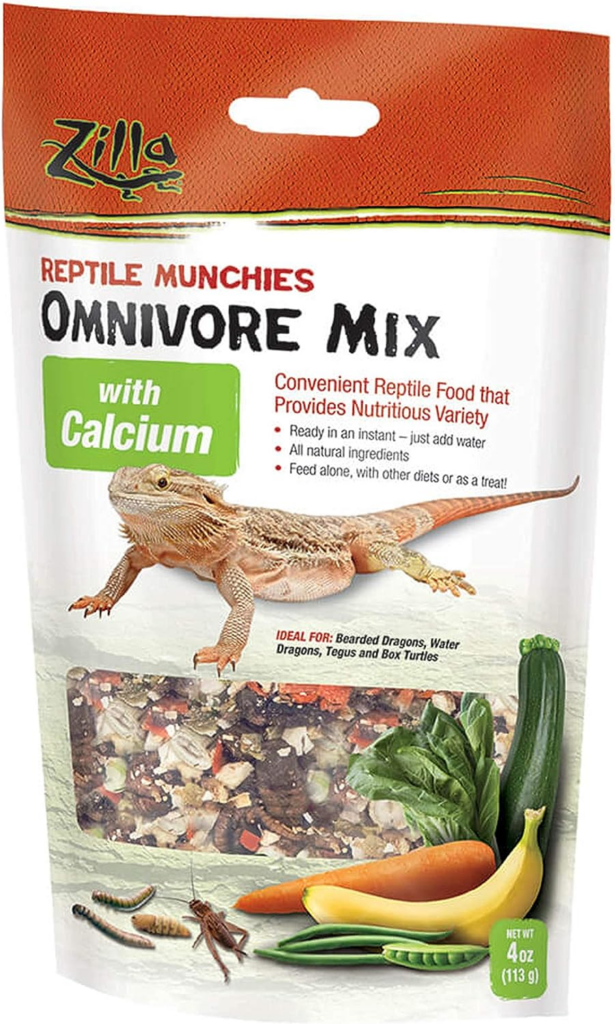 Zilla Omnivore Mix – Насекоми, Плодове и зеленчуци + калций | 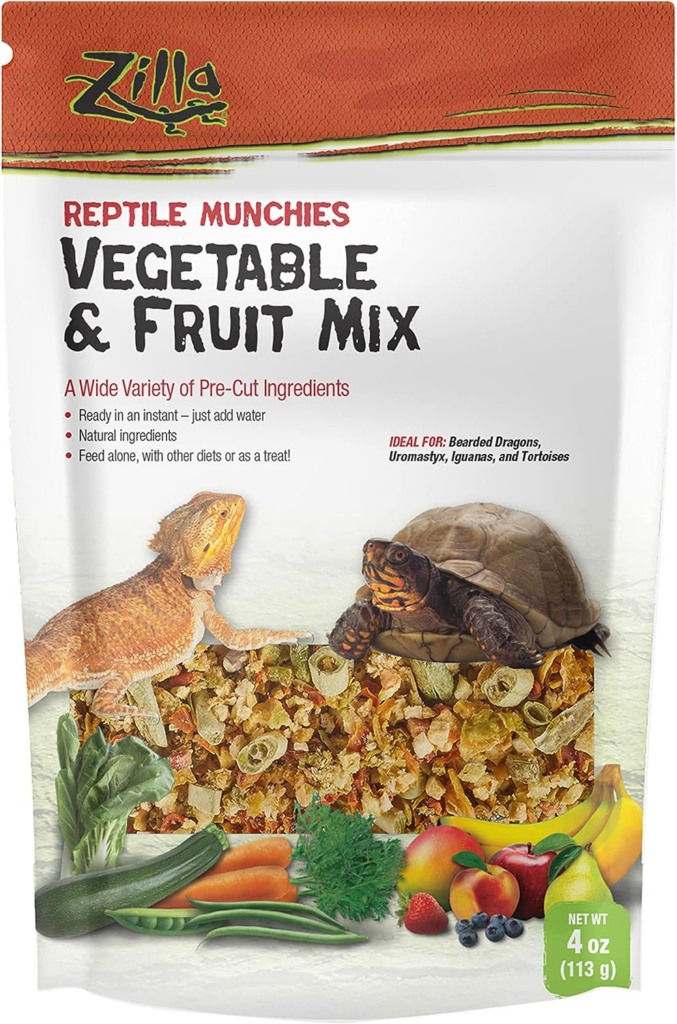 Микс от зеленчуци и плодове Zilla | 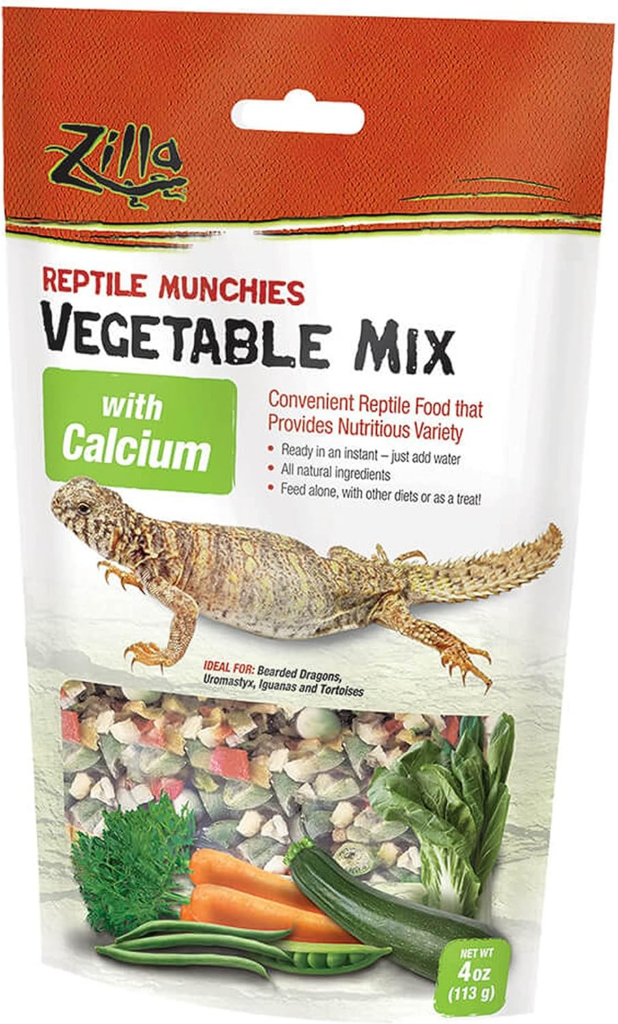 Зеленчуков микс Zilla + калций |
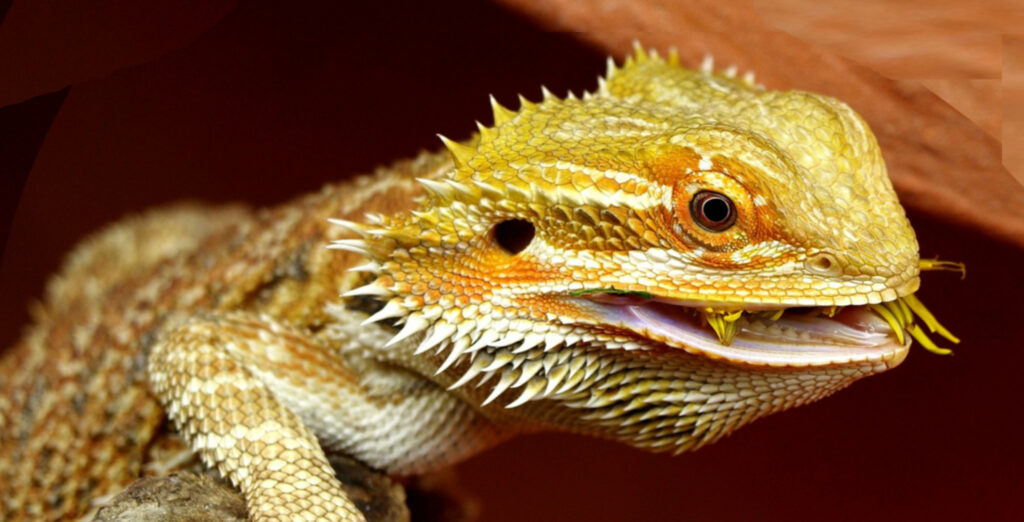
Bearded Dragon Diet FAQs
What should I feed my bearded dragon, and how often?
Your bearded dragon’s diet should consist of a balance of greens and insects.
For adult dragons, focus on 85% зелени и 15% насекоми, while juveniles should have 70-85% insects and the rest greens.
This ensures they get the nutrients they need at different stages of life.
What are the best feeder insects for bearded dragons?
The best feeder insects for bearded dragons are those that are high in protein and calcium, and low in fat. Some of the best options include:
- Хлебарки Dubia
- Ларви на черна войнишка муха
- Копринени буби
- Брашнени червеи
- Суперчервеи
- Восъчни червеи
It is important to choose a variety of feeder insects to ensure that your bearded dragon is getting all the nutrients it needs.
What is gut-loading and why is it important for bearded dragons?
Gut-loading is the process of feeding feeder insects nutritious food before you feed them to your bearded dragon.
This helps to ensure that your dragon is getting the nutrients it needs from the insects.
You can gut-load feeder insects with fruits, зеленчуци, зеленина, and even calcium powder.
Gut-loading is important for bearded dragons because they are not able to digest all of the nutrients in insects on their own.
By gut-loading the insects, you are providing them with the nutrients they need to stay healthy.
How many insects do baby bearded dragons need?
Baby bearded dragons need to eat a lot of insects to grow and develop properly. They should be fed insects 3-4 пъти на ден, and the amount of insects you feed them will depend on their age and size.
A good rule of thumb is to feed baby bearded dragons as many insects as they can eat in 15 минути.
As they get older, you can gradually decrease the number of insects you feed them.
Why is it important to choose the right greens for my beardie?
Selecting the right greens is crucial as an improper diet can lead to health problems.
Bearded dragons can develop cholelithiasis (gallbladder problems) from an unbalanced diet.
It’s vital to provide a balanced, plant-based diet to prevent such issues.
Which vegetables should I be cautious about feeding my bearded dragon?
Exercise caution with cruciferous vegetables like kale, broccoli, and Brussels sprouts.
These can interfere with thyroid function due to their goitrogenic compounds. Avoid overfeeding these greens to prevent potential health issues.
What about oxalates in vegetables? Are they harmful to my dragon?
Oxalic acid in certain plants, such as spinach and kale, can inhibit calcium absorption.
While specific limits for bearded dragons are uncertain, it’s best to keep soluble oxalate intake below 0.5% of their diet to ensure calcium absorption.
Why should I avoid store-bought pelleted food for my dragon?
Store-bought pelleted food lacks essential nutrients and is akin to fast food for dragons.
Bearded dragons thrive on a diet that includes live prey for stimulation and proper nutrition, replicating their natural feeding habits.
Is it okay to feed “spring mix” or “power greens” from the store?
While “spring mix” and “power greens” can be used occasionally, they often contain low-nutrient lettuces and spinach.
Avoid making these mixes a staple in your dragon’s diet to ensure they receive a well-rounded nutrition.
What should I include in my dragon’s diet?
Ensure variety in your dragon’s diet by including non-goitrogenic greens (e.g., зеленина от глухарче, ендивия), goitrogenic greens (e.g., зеле, mustard greens), and other vegetables (e.g., скуош, sweet potato).
Rotate these options for a balanced diet.
What fruits can I feed my bearded dragon?
Offer occasional fruits like strawberries, боровинки, and melons as treats.
Avoid citrus fruits as they can be harmful to your dragon’s health.
Is cooking necessary for vegetables and greens?
There’s no need to cook vegetables for your beardie. Simply cut them into smaller, manageable pieces for easy consumption.
Cooking may be necessary if your dragon is unwell or having difficulty eating.
БРАДАТ ДРАКОН БЪРЗИ ВРЪЗКИ
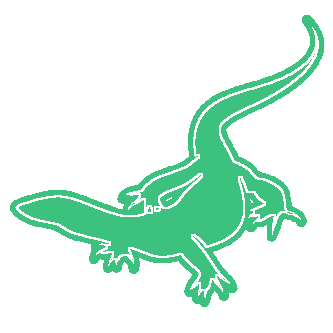
PetsWithScales.com е информационен уебсайт за грижи за домашни любимци на големи гущери. Ние събираме и предоставяме информация от различни източници в мрежата за това как да отглеждаме и да се грижим за влечугите като домашни любимци. Видовете, с които се занимаваме основно са тегу, варан, сцинкове и гекони. Нашата цел е да предоставим висококачествена информация, за да помогнем на собствениците на домашни любимци да се подобрят, по-информирани решения относно диетите на техните животни, здраве и живот.

PetsWithScales.com е информационен уебсайт за грижи за домашни любимци на големи гущери. Ние събираме и предоставяме информация от различни източници в мрежата за това как да отглеждаме и да се грижим за влечугите като домашни любимци. Видовете, с които се занимаваме основно са тегу, варан, сцинкове и гекони. Нашата цел е да предоставим висококачествена информация, за да помогнем на собствениците на домашни любимци да се подобрят, по-информирани решения относно диетите на техните животни, здраве и живот.
